MISKATONIC
UNIVERSITY
College of
Metaphysics
,,,
... |
|
The Book of Kells
DESCRIBED BY
SIR EDWARD SUL-
LIVAN, BART., AND
ILLUSTRATED WITH
TWENTY-FOUR PLATES
IN COLOURS
MCMXIV
"THE STUDIO" LTD.
LONDON, PARIS, NEW YORK
(1914)
1st Edition
MISKATONIC UNIVERSITY PRESS
ARKHAM - ROCKPORT - BROOKLINE
2003
Copyright © 2003 Miskatonic
University Press/ yankeeclass.com, all rights reserved
.
|
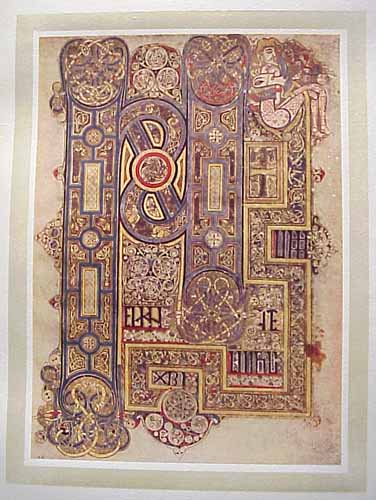 An
Irish manuscript containing the Four Gospels, a fragment of Hebrew names,
and the Eusebian canons, known also as the "Book of Columba", probably
because it was written in the monastery of Iona to honor the saint. It
is likely that it is to this book that the entry in the "Annals of Ulster"
under the year 1006 refers, recording that in that year the "Gospel of
Columba" was stolen. According to tradition, the book is a relic
from the time of Columba (d. 597) and even the work of his hands, but,
on palæographic grounds and judging by the character of the ornamentation,
this tradition cannot be sustained, and the date of the composition of
the book can hardly be placed earlier than the end of the seventh or beginning
of the eighth century. This must be the book which the Welshman, Geraldus
Cambrensis, saw at Kildare in the last quarter of the twelfth century and
which he describes in glowing terms (Topogr. Hibern., II, xxxviii). An
Irish manuscript containing the Four Gospels, a fragment of Hebrew names,
and the Eusebian canons, known also as the "Book of Columba", probably
because it was written in the monastery of Iona to honor the saint. It
is likely that it is to this book that the entry in the "Annals of Ulster"
under the year 1006 refers, recording that in that year the "Gospel of
Columba" was stolen. According to tradition, the book is a relic
from the time of Columba (d. 597) and even the work of his hands, but,
on palæographic grounds and judging by the character of the ornamentation,
this tradition cannot be sustained, and the date of the composition of
the book can hardly be placed earlier than the end of the seventh or beginning
of the eighth century. This must be the book which the Welshman, Geraldus
Cambrensis, saw at Kildare in the last quarter of the twelfth century and
which he describes in glowing terms (Topogr. Hibern., II, xxxviii).
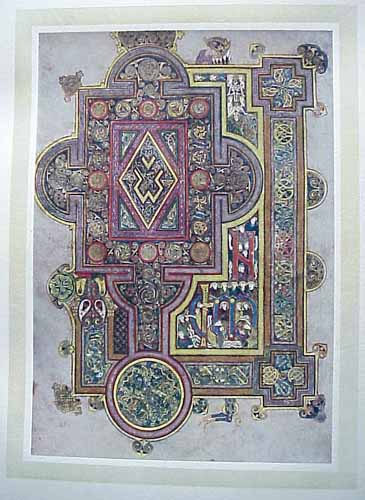 We
next hear of it at the cathedral of Kells (Irish Cenannus) in Meath, a
foundation of Columba's, where it remained for a long time, or until the
year 1541. In the seventeenth century Archbishop Ussher presented it to
Trinity College, Dublin, where it is the most precious manuscript (A. I.
6) in the college library and by far the choicest relic of Irish art that
has been preserved. In it is to be found every variety of design typical
of Irish art at its best. We
next hear of it at the cathedral of Kells (Irish Cenannus) in Meath, a
foundation of Columba's, where it remained for a long time, or until the
year 1541. In the seventeenth century Archbishop Ussher presented it to
Trinity College, Dublin, where it is the most precious manuscript (A. I.
6) in the college library and by far the choicest relic of Irish art that
has been preserved. In it is to be found every variety of design typical
of Irish art at its best.
|
.
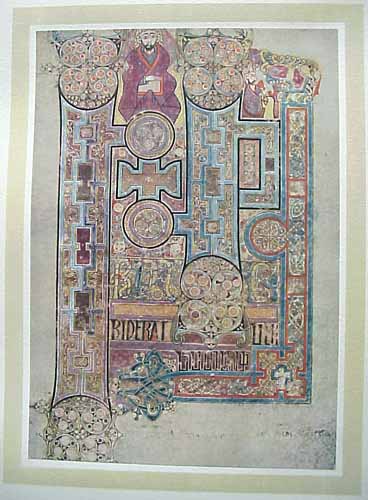 Some
small portions at the beginning and end of the manuscript have been lost,
but otherwise it is in a very good state of preservation. It was apparently
left unfinished, since some of the ornaments remain only in outline. It
is written in part black, red, purple or yellow ink, and it has been
thought that the hands of two scribes, neither of whom is known to us by
name, are discernible in the writing and illumination of the manuscript.
The most characteristic ornaments of the Book of Kells, as of other illuminated
Irish manuscripts of the period, are the closely coiled spirals connected
with each other by a number of curves and terminating in the so-called
"trumpet pattern". Almost equally characteristic are the zoomorphic interlacements,
colored representations of fanciful beings, or of men, animals, birds,
horses, dogs, and grotesque, gargoyle-like human figures, twisted and hooked
together in intricate detail. Some
small portions at the beginning and end of the manuscript have been lost,
but otherwise it is in a very good state of preservation. It was apparently
left unfinished, since some of the ornaments remain only in outline. It
is written in part black, red, purple or yellow ink, and it has been
thought that the hands of two scribes, neither of whom is known to us by
name, are discernible in the writing and illumination of the manuscript.
The most characteristic ornaments of the Book of Kells, as of other illuminated
Irish manuscripts of the period, are the closely coiled spirals connected
with each other by a number of curves and terminating in the so-called
"trumpet pattern". Almost equally characteristic are the zoomorphic interlacements,
colored representations of fanciful beings, or of men, animals, birds,
horses, dogs, and grotesque, gargoyle-like human figures, twisted and hooked
together in intricate detail.
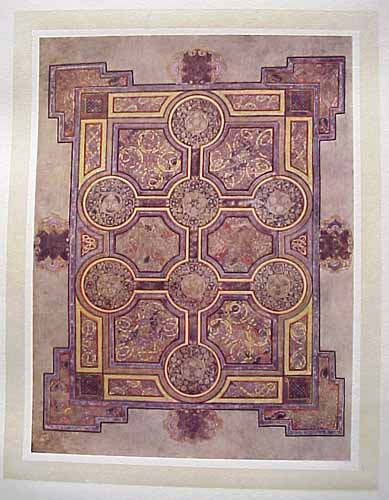 Other
frequently occurring designs are a system of geometrical weaving of ribbons
plaited and knotted together, and a simpler ornamentation by means of red
dotted lines. The versatility and inventive genius of the illustrator surpasses
all belief. Lines diverge and converge in endless succession, and the most
intricate figures, in lavish abundance and with astounding variety of ornament,
are combined and woven into one harmonious design. In spite of the extent
of the work and its thousands of exquisite initials and terminals, there
is not a single pattern or combination that can be said to be a copy of
another. The artist shows a wonderful technique in designing and combining
various emblems, the cross, vine, dragon, fish, and serpent. The drawing
is perfection itself. It has been examined under a powerful magnifying
glass for hours at a time and found to be, even in the most minute and
complicated figures, without a single false or irregular line. Some of
the most accomplished of modern draughtsmen have attempted to copy its
elaborate designs, but, such is the delicacy of the execution, that they
had to abandon the task as hopeless. In a space of one inch square were
counted no less than 158 interlacings of white ribbon with a black border
on either side. On the other hand, the pictures of the personages delineated
are feeble and primitive and show but a limited knowledge of the human
figure and its relative proportions. Other
frequently occurring designs are a system of geometrical weaving of ribbons
plaited and knotted together, and a simpler ornamentation by means of red
dotted lines. The versatility and inventive genius of the illustrator surpasses
all belief. Lines diverge and converge in endless succession, and the most
intricate figures, in lavish abundance and with astounding variety of ornament,
are combined and woven into one harmonious design. In spite of the extent
of the work and its thousands of exquisite initials and terminals, there
is not a single pattern or combination that can be said to be a copy of
another. The artist shows a wonderful technique in designing and combining
various emblems, the cross, vine, dragon, fish, and serpent. The drawing
is perfection itself. It has been examined under a powerful magnifying
glass for hours at a time and found to be, even in the most minute and
complicated figures, without a single false or irregular line. Some of
the most accomplished of modern draughtsmen have attempted to copy its
elaborate designs, but, such is the delicacy of the execution, that they
had to abandon the task as hopeless. In a space of one inch square were
counted no less than 158 interlacings of white ribbon with a black border
on either side. On the other hand, the pictures of the personages delineated
are feeble and primitive and show but a limited knowledge of the human
figure and its relative proportions.
|
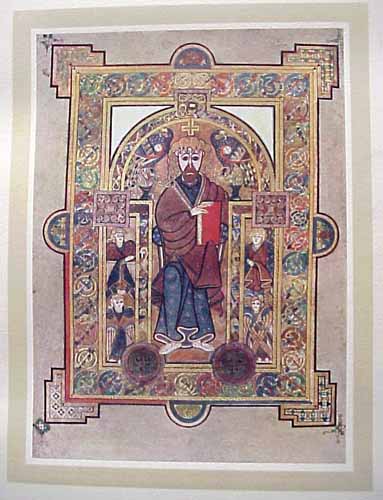 No
words can describe the beauty and the extreme splendor of the richly colored
initial letters, which are more profuse in the "Book of Kells" than in
any other manuscript. The only thing to which they can be compared is a
bed of many colored crocuses and tulips or the very finest stained glass
window, which they equal in beauty of coloring and rival in delicacy of
ornament and drawing. The artist possessed a wonderful knowledge of the
proportion of color and the distribution of his material -- sienna, purple,
lilac, red, pink, green, yellow, the colors most often used -- and he managed
the shading and tinting of the letters with consummate taste and skill.
It is remarkable that there is no trace of the use of silver or gold on
the vellum. Sometimes the colors are laid on in thick layers to give the
appearance of enamel, and are here and there as bright and soft and lustrous
as when put on fresh more than twelve hundred years ago. No
words can describe the beauty and the extreme splendor of the richly colored
initial letters, which are more profuse in the "Book of Kells" than in
any other manuscript. The only thing to which they can be compared is a
bed of many colored crocuses and tulips or the very finest stained glass
window, which they equal in beauty of coloring and rival in delicacy of
ornament and drawing. The artist possessed a wonderful knowledge of the
proportion of color and the distribution of his material -- sienna, purple,
lilac, red, pink, green, yellow, the colors most often used -- and he managed
the shading and tinting of the letters with consummate taste and skill.
It is remarkable that there is no trace of the use of silver or gold on
the vellum. Sometimes the colors are laid on in thick layers to give the
appearance of enamel, and are here and there as bright and soft and lustrous
as when put on fresh more than twelve hundred years ago.
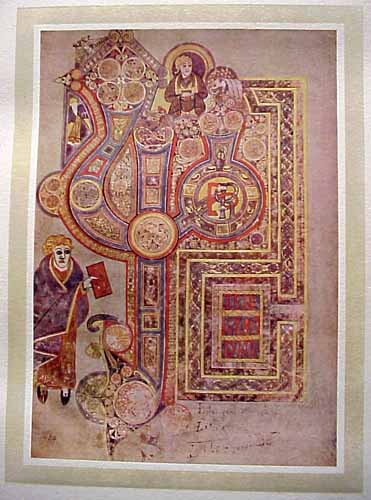 Even
the best photographic and color reproductions give but a faint idea of
the beauty of the original. Especially worthy of notice is the series of
illuminated miniatures, including pictorial representations of the Evangelists
and their symbols, the Blessed Virgin and the Divine Child, the temptation
of Jesus, and Jesus seized by the Jews. These pictures reach their culminating
point in what is, in some respects, the most marvelous example of workmanship
that the world has ever produced, namely the full page monogram XPI which
occurs in the text of the Gospel of St. Matthew. It is no wonder that it
was for a long time believed that the "Book of Kells" could have been written
only by angels. Even
the best photographic and color reproductions give but a faint idea of
the beauty of the original. Especially worthy of notice is the series of
illuminated miniatures, including pictorial representations of the Evangelists
and their symbols, the Blessed Virgin and the Divine Child, the temptation
of Jesus, and Jesus seized by the Jews. These pictures reach their culminating
point in what is, in some respects, the most marvelous example of workmanship
that the world has ever produced, namely the full page monogram XPI which
occurs in the text of the Gospel of St. Matthew. It is no wonder that it
was for a long time believed that the "Book of Kells" could have been written
only by angels.
|
Sir Edward Sullivan
1822-1885
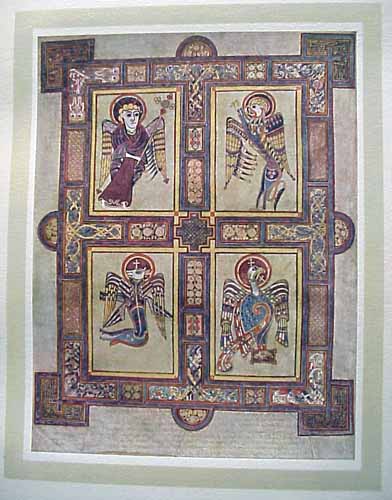 Sir
Edward Sullivan, lord chancellor of Ireland, was born at Mallow, co. Cork,
on 10 July 1822. He was the eldest son of Edward Sullivan by his
wife Anne Surflen, née Lynch. His father, a local merchant, realised
a substantial fortune in business and was a friend of the poet Moore. Sullivan
received his earliest education at a school in his native town, and later
on was sent to the endowed school at Midleton, an institution in which
many distinguished Irishmen, Curran and Barry Yelverton among them, had
been trained. In 1841 he entered Trinity College, Dublin. His career at
the university was distinguished. He obtained first classical scholarship
in 1843, and graduated B.A. in 1845. He was also elected auditor of the
college historical society in 1845, in succession to William Connor Magee
(afterwards bishop of Peterborough and archbishop of York), and gained
the gold medal for oratory. In 1848, after two years of preliminary study
at chambers in London, Sullivan was called to the Irish bar, where his
well-trained and richly stored mind, his great readiness, indomitable tenacity,
and fiery eloquence very quickly brought him into notice. Within ten years
of his call to the bar (1858) he was appointed a queen's counsel, and two
years later, during the viceroyalty of Lord Carlisle, became one of the
three serjeants-at-law. In 1861 he was appointed law adviseran office subordinate
to the attorney and solicitor general, which has since been abolishedand
in 1865 became for a brief period solicitor-general for Ireland in Lord
Palmerston's last administration. In this capacity he was called on to
deal with the fenian conspiracy. In 1865 he was returned in the liberal
interest to represent his native town in parliament. From 1866 to 1868,
while his party was in opposition, he applied himself mainly to his profession,
and acted, about this period, in conjunction with James Whiteside, as leading
counsel for the plaintiff in the celebrated Yelverton trial. Sir
Edward Sullivan, lord chancellor of Ireland, was born at Mallow, co. Cork,
on 10 July 1822. He was the eldest son of Edward Sullivan by his
wife Anne Surflen, née Lynch. His father, a local merchant, realised
a substantial fortune in business and was a friend of the poet Moore. Sullivan
received his earliest education at a school in his native town, and later
on was sent to the endowed school at Midleton, an institution in which
many distinguished Irishmen, Curran and Barry Yelverton among them, had
been trained. In 1841 he entered Trinity College, Dublin. His career at
the university was distinguished. He obtained first classical scholarship
in 1843, and graduated B.A. in 1845. He was also elected auditor of the
college historical society in 1845, in succession to William Connor Magee
(afterwards bishop of Peterborough and archbishop of York), and gained
the gold medal for oratory. In 1848, after two years of preliminary study
at chambers in London, Sullivan was called to the Irish bar, where his
well-trained and richly stored mind, his great readiness, indomitable tenacity,
and fiery eloquence very quickly brought him into notice. Within ten years
of his call to the bar (1858) he was appointed a queen's counsel, and two
years later, during the viceroyalty of Lord Carlisle, became one of the
three serjeants-at-law. In 1861 he was appointed law adviseran office subordinate
to the attorney and solicitor general, which has since been abolishedand
in 1865 became for a brief period solicitor-general for Ireland in Lord
Palmerston's last administration. In this capacity he was called on to
deal with the fenian conspiracy. In 1865 he was returned in the liberal
interest to represent his native town in parliament. From 1866 to 1868,
while his party was in opposition, he applied himself mainly to his profession,
and acted, about this period, in conjunction with James Whiteside, as leading
counsel for the plaintiff in the celebrated Yelverton trial.
 In
December 1868, on the return of the liberal party to power, Sullivan became
attorney-general for Ireland in Mr. Gladstone's first administration. He
took an activenext to the prime minister, the leadingpart in the conduct
of the Irish Church Bill in the House of Commons. His services on this
occasion, the debating ability he displayed in the stormy discussions which
the bill provoked, and his knowledge and grasp of the details of a most
intricate subject, raised him to a high place in the estimation of the
House of Commons, and earned him the complete confidence of his leader.
He retired from parliament in 1870 to become master of the rolls in Ireland.
Until 1882 he was mainly engrossed by his judicial duties; but he was also
an active member of the privy council. His advice was often sought on critical
occasions by the Irish government. Mr. Gladstone placed much reliance on
his judgment and knowledge of Ireland, and it was mainly at his instance
that the important step of arresting Charles Stewart Parnell was adopted
by the government in 1881. In December 1881 Sullivan was created
a baronet on the recommendation of Mr. Gladstone, in recognition of his
services both as a judge and as a confidential adviser of the servants
of the crown in Ireland; and shortly afterwards the premature death of
Hugh Law opened the way for his elevation to the Irish chancellorship,
to which he was appointed in 1883. In this capacity he displayed governing
qualities of the highest order, and during the troubled period of Lord
Spencer's second viceroyalty he may be said to have been the mainspring
of the Irish government in the measures taken to stamp out the Invincible
conspiracy. He enjoyed his office for a comparatively brief period, dying
suddenly at his house in Dublin on 13 April 1885. In
December 1868, on the return of the liberal party to power, Sullivan became
attorney-general for Ireland in Mr. Gladstone's first administration. He
took an activenext to the prime minister, the leadingpart in the conduct
of the Irish Church Bill in the House of Commons. His services on this
occasion, the debating ability he displayed in the stormy discussions which
the bill provoked, and his knowledge and grasp of the details of a most
intricate subject, raised him to a high place in the estimation of the
House of Commons, and earned him the complete confidence of his leader.
He retired from parliament in 1870 to become master of the rolls in Ireland.
Until 1882 he was mainly engrossed by his judicial duties; but he was also
an active member of the privy council. His advice was often sought on critical
occasions by the Irish government. Mr. Gladstone placed much reliance on
his judgment and knowledge of Ireland, and it was mainly at his instance
that the important step of arresting Charles Stewart Parnell was adopted
by the government in 1881. In December 1881 Sullivan was created
a baronet on the recommendation of Mr. Gladstone, in recognition of his
services both as a judge and as a confidential adviser of the servants
of the crown in Ireland; and shortly afterwards the premature death of
Hugh Law opened the way for his elevation to the Irish chancellorship,
to which he was appointed in 1883. In this capacity he displayed governing
qualities of the highest order, and during the troubled period of Lord
Spencer's second viceroyalty he may be said to have been the mainspring
of the Irish government in the measures taken to stamp out the Invincible
conspiracy. He enjoyed his office for a comparatively brief period, dying
suddenly at his house in Dublin on 13 April 1885.
In the list of Irish chancellors of the nineteenth century Sullivan
is one of the most eminent. But he was more distinguished as a statesman
than as a judge. His thorough knowledge of Ireland, combined with the courage,
firmness, and decision of his character, qualified him to be what during
the period of his chancellorship he wasan active champion of law and order
throughout the country. Sullivan was also a man of varied accomplishments
and scholarly tastes. Through life he was an ardent book-collector, and
at his death had amassed one of the most valuable private libraries in
the kingdom. Part of this library, when sold by auction in 1890, realised
11,000l.. Besides being a sound classical scholar, he was a skilled
linguist, and familiar with German, French, Italian, and Spanish literature.
Sullivan married, on 24 Sept. 1850, Bessie Josephine, daughter of Robert
Bailey of Cork, by whom he had issue four sons and one daughter
...
|
    |
| Copyright © 2002 Miskatonic
University Press/ yankeeclass.com, all rights reserved |
|
|
|
|
|
|